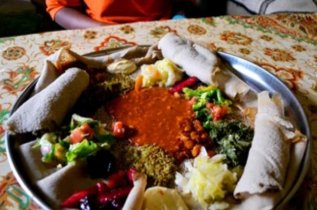 Traditional instruments used in Ethiopian music include a one stringed violin like instrument that is played with a bow known as the masinqo; a 6 figured krar played either with the fingers or less often with a plectrum; a flute made from bamboo called the washint and various drums from the stick played negarit; the hand beaten kebero and the atamo which is played by tapping with the fingers or palm of the hand. Other popular instruments in Ethiopian music include a large harp (begena), a trumpet known as the tsinatsil and a ceremonial flute called the embilta.
Traditional instruments used in Ethiopian music include a one stringed violin like instrument that is played with a bow known as the masinqo; a 6 figured krar played either with the fingers or less often with a plectrum; a flute made from bamboo called the washint and various drums from the stick played negarit; the hand beaten kebero and the atamo which is played by tapping with the fingers or palm of the hand. Other popular instruments in Ethiopian music include a large harp (begena), a trumpet known as the tsinatsil and a ceremonial flute called the embilta.
It is estimated that there are some one hundred and fifty unique dancing movements across Ethiopia and this is reflected in the diverse range of Ethiopian music which varies from folk music from the Horn of Africa to ancient Christian based music and the Muslim musical form of 'Manzuma' amongst others. The video (below) shows children performing traditional Ethiopian dancing. Keep your eye out for the little lad in white shorts and a top reflecting his country's colours. He becomes totally absorbed by the dance and music and symbolises the sheer energy and joy of Ethiopian dancing where traditional dancing styles are based on movement of the upper body flowing out through the entire body creating a spiritual experience.
Turning to the other mainstay of life in Ethiopia, Ethiopian food is very spicy for one main reason the spices help preserve meat as refrigeration is rare. This spicy paste 'Berbere' (made from red chili peppers, garlic and other spices, then dried out and mixed with yet more spices and formed into a paste) has another attraction, for in Ethiopian culture the woman who can make the best Berbere has the greatest chance of winning a good husband! Stew called 'wat' is an important traditional Ethiopian food and is made with chicken, beef, fish, or just vegetables, again, it is normally spiced up with paprika.
Food is often eaten with the fingers and injera, (a pancake like bread that's one of Ethiopian children's favourite foods) forms the backbone of the meal, with strips of injera being torn off and wrapped out portions of the dishes made, then eaten. (However for the uninitiated forks are allowed!) It's easier to imagine this as the injera (above) being like a tablecloth with portions of food being served on it, then you eat the tablecloth! Other popular food in Ethiopia includes dulet (meat and peppers with injera) or fir-fir (a pancake with egg and honey) both for breakfast whilst popcorn and Kolo (roasted barley) are both popular snacks.

